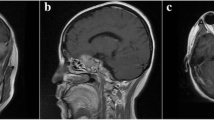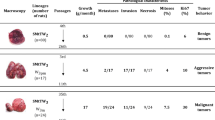Abstract
A 25-year-old woman developed Nelson’s syndrome, 3 years after successful bilateral adrenalectomy for Cushing’s disease. Despite pituitary surgery and radiotherapy the tumour showed invasive growth, Ieading to visual disturbance, paresis of the oculomotor nerve and, 34 years after adrenalectomy, to death by widespread purulent leptomeningitis. Autopsy revealed a large adenohypophyseal carcinoma with a metastasis attached to the dura, both tumours showing immunocytochemical staining for ACTH and TSH. We review the literature on metastatic adenohypophyseal carcinoma in Cushing’s disease and Nelson’s syndrome and discuss the role of proliferation markers as indicators of malignant progression.
Similar content being viewed by others
References
Kemink L., Pieters G., Hermus A., Smals A., Kloppenborg T. Patient’s age is a simple predictive factor for the development of Nelson’s syndrome after total adrena-lectomy for Cushing’s disease. J. Clin. Endocrinol. Metab. 79: 887, 1994.
Pernicone P., Scheithauer S. Invasive pituitary adenomas and pituitary carcinomas. In R.V. Lloyd (Ed.), Surgical Pathology of the Pituitary Gland. W.B. Saunders Co, Philadelphia, 1993, p. 121.
Selman W., Laws E., Scheithauer B., Carpenter S. The occurrence of dural invasion in pituitary adenomas. J. Neurosurg. 64: 402, 1986.
Scheithauer B., Kovacs K., Laws E., Randall R. Pathology of invasive pituitary tumors with special reference to functional classification. J. Neurosurg. 65: 733, 1986.
Kovacs K., Scheithauer B., Horvath E., Lloyd R. The World Health Organization classification of ade-nohypophyseal neoplasms; a proposed five-tier scheme. Cancer 78: 502, 1996.
Shaffi O., Wrightson P. Dural invasion by pituitary tumours. New Zealand Med. J. 81: 386, 1975.
Wrightson P. Conservative removal of small pituitary tumours: is it justified by the pathological findings? Neurol. Neurosurg. Psych. 41: 283, 1978.
Hardy J. Transsphenoidal surgery of hypersecreting tumors. In: Kohler P.O., Ross G.T. (Eds.), Diagnosis and treatment of pituitary tumors. International Congress Series. New York: American Elsevier, 1973, vol. 303, p. 179.
Kovacs K., Horvath E. Malignancy. In Tumors of the Pituitary Gland. Washington, DC: Armed Forces Institute of Pathology, 1986, p. 217.
Pernicone P., Scheithauer B., Sebo T., Kovacs K., Horvath E., Young W., Lloyd R., Davis D., Guthrie B., Schoene W. Pituitary Carcinoma; a clinicopathologic study of 15 cases. Cancer 79: 804, 1997.
Thapar K., Kovacs K., Scheithauer B., Stefaneanu. L., Horvath E., Murray D., Laws E. Proliferative activity and invasiveness among pituitary adenomas and carcinomas: an analysis using the MIB-1 antibody. Neurosurg. 35: 1012, 1996.
Hsu D., Hakim F., Biller B., De La Monte S., Zervas N., Klibanski A., Hedley-Whyte E. Significance of proliferating cell nuclear antigen index in predicting pituitary adenoma recurrence. J. Neurosurg. 78: 753, 1993.
Fornas O., Mato M., Viader M., Oliver B., Tresserres P., Bartumeus F., Tugues D., Petriz J., Matias-Guiu X., Webb S. Flow cytometry analysis of pituitary adenomas. Horm. Res. 46: 257, 1996.
Lüke D., Saeger W., Üdecke D. Proliferation markers and EGF in ACTH-secreting adenomas and carcinomas of the pituitary. Endocr. Pathol. 6: 45, 1995.
Clayton R., Boggild M., Bates A., Bicknell J., Simpson D., Farrell W. Tumour suppressor genes in the pathogenesis of human pituitary tumours. Horm. Res. 47: 185, 1997.
Pei L., Melmed S. Isolation and characterization of a pituitary tumor-transforming gene (PTTG). Mol. Endocrinol. 11: 433, 1997.
Thapar K., Scheithauer B., Kovacs K., Pernicone P., Laws E. p53 expression in pituitary adenomas and carcinomas: correlation with invasiveness and tumor growth fractions. Neurosurgery. 38: 777, 1996.
Harris P. Gs Protein mutations and the pathogenesis and function of pituitary tumors. Metabolism 45, (Suppl. 1) 120, 1996.
Williamson E., Ince P., Harrison D. G-protein mutations in human pituitary adenocorti-cotrophic hormone-secreting adenomas. Eur. J. Clin. Invest. 25: 128, 1995.
Kemink S., Smals A., Hermus A., Pieters G., Kloppenborg P. Nelson’s syndrome: a reviewy. The Endocrinologist 7/1: 5, 1997.
Cohen H., Dible J. Pituitary basophilism associated with a basophil carcinoma of the anterior lobe of the pituitary gland. Brain 59: 395, 1936.
Forbes W. Carcinoma of the pituitary gland with metastases to the liver in a case of Cushing’s syndrom. J. Pathol. Bacteriol. 59: 137, 1947.
Sheldon W., Golden A., Bondy P. Cushing’s syndrome produced by a pituitary carcinoma with hepatic metastases. Am. J. Med. 17: 134, 1954.
Salassa R., Kearns T., Kernohan J., Sprague R., MacCarty C. Pituitary tumors in patients with Cushing’s syndrome. J. Clin. Endocrinol. Metab. 19: 1523, 1959.
Scholz D., Gastineau C., Harrison E. Cushing’s syndrome with malignant chromophobe tumor of pituitary and extracranial metastases. Proceedings of Staff Meetings of the Mayo Clinic. 37: 31, 1962.
Queiroz L., Facure N., Facure J., Modesto N., Le Faria J. Pituitary carcinoma with liver metastases in Cushing’s syndrome. Arch. Pathol. 99: 32, 1975.
Moore T., Dluhy R., Williams G., Gain J. Nelson’s syndrome: frequency, prognosis, and effects of prior pituitary irradiation. Ann. Intern. Med. 85: 731, 1976.
Kaiser F., Orth D., Mukai K., Oppenhemer J. Pituitary parasellar tumor with extracranial metastases and high, partially suppressible levels of adrenocorticotropin and related peptides. Clin. Endocrinol. Metab. 57: 649, 1983.
Papotti M., Limone P., Riva C., Gatti G., Bussolati G. Malignant evolution of an ACTH-producing tumor treated with intrasellar implantation of 90Y. Case report and review of the literature. J. Appl. Pathol. 2: 10, 1984.
Gabrilove J., Anderson P., Halmi N. Pituitary Pro-opiomelanocortin-cell carcinoma occurring in conjunction with a glioblastoma in a patient with Cushing’s disease and subsequent Nelson’s syndrome. Clin. Endocrinol. (Oxf.) 25: 117, 1986.
Nawata H., Higuchi K., Ikuyama S., Kato K., Ibayashi H., Mimura K., Sueishi K., Zingami H., Imura H. Corticotropin-Releasing Hormone- and Adrenocor-ticotropin-Producing pituitary carcinoma with metastases to the liver and lung in a patient with Cushing’s disease. J. Clin. Endocrinol. Metab. 71: 1068, 1990.
Levesque H., Freger P., Gancel A., Tayot J., Courtis H. Primary carcinoma of the pituitary gland with Cushing’s syndrome and metastases. Apropos of a case with review of the literature. La Revue de Médicine Interne 12: 209, 1991.
Tonner D., Belding P., Moore S., Schlechte J. Intracranial dissemination of an ACTH-secreting pituitary neoplasm-a case report and review of the literature. J. Endocrinol. Invest. 15: 387, 1992.
Frost A., Tenner S., Tenner M., Rollhauser C., Tabbara S. ACTH-producing pituitary carcinoma presenting as the cauda equina syndrome. Arch. Pathol. Lab. Med. 119: 93, 1995.
Garrao A., Sobrinho L., Oliveira P., Bugalho M., Boavida J., Raposo J., Loureiro M., Limbert E., Costa L., Antunes J. ACTH-producing carcinoma of the pituitary with haematogenic metastases. J. Endocrinol. 137: 176, 1997.
Aydin F., Ghatak N., Leshner R. Possible radiation-induced dural fibrosarcoma with an unusually short latent period: case report. Neurosurgery 36: 591, 1995.
Brada M., Ford D., Ashley S., Bliss L., Crowley S., Mason M., Rajan B., Traish D. Risk of second brain tumour after conservative surgery and radiation- therapy for pituitary adenoma. Br. Med. J. 304: 1343, 1992.
Jenkins P., Trainer P., Plowman P., Shand W., Grossman A., Wass J., Besser G. The long-term outcome after adrenalectomy and prophylactic pituitary radiotherapy in adrenocorti-cotropin-dependent Cushing’s syndrome. J. Clin. Endocrinol. Metab. 79: 165, 1994.
Kuhn J., Proeschel M., Seurin D., Bertagna X., Luton J., Girard F. Comparative assessment of ACTH and Lipotropin plasma levels in the diagnosis and follow-up of patients with Cushing’s syndrome: a study of 210 cases. J. Med. 86: 678, 1989.
Howlett T., Plowman P., Wass J., Rees L., Jones A., Besser G. Megavoltage pituitary irradiation in the management of Cushing’s disease and Nelson’s syndrome: long-term follow-up. Clin. Endocrinol. (Oxf.) 31: 309, 1989.
Littley M., Shalet S., Beardwell C., Ahmed S., Sutton M. Long-term follow-up of low-dose external pituitary irradiation for Cushing’s disease. Clin. Endocrinol. (Oxf.) 33: 44, 1990.
Mixson A., Friedman T., Katz D., Feuerstein I., Taubenberger J., Colandrea J., Doppman J., Oldfield E., Weintraub B. Thyrotropin-secreting pituitary carcinoma. J. Clin. Endocrinol. Metab. 76: 529, 1993.
Petterson T., MacFarlane I., MacKenzie J., Shaw M. Prolactin-secreting pituitary carcinoma. J. Neurol. Neurosurg. Psychiatry 55: 1205, 1992.
Author information
Authors and Affiliations
Additional information
An erratum to this article is available at http://dx.doi.org/10.1007/BF03343613.
Rights and permissions
About this article
Cite this article
Kemink, S.A.G., Wesseling, P., Pieters, G.F.F.M. et al. Progression of a Nelson’s adenoma to pituitary carcinoma; a case report and review of the literature. J Endocrinol Invest 22, 70–75 (1999). https://doi.org/10.1007/BF03345482
Accepted:
Published:
Issue Date:
DOI: https://doi.org/10.1007/BF03345482




